
-
 History of Religions
History of the 3 Monotheistic religions (Judaism, Christianity and Islam) and of the main different Christianity confessions (Roman Catholicism, Eastern Catholicism and Eastern Orthodoxy, Anglicanism and Protestantism)
History of Religions
History of the 3 Monotheistic religions (Judaism, Christianity and Islam) and of the main different Christianity confessions (Roman Catholicism, Eastern Catholicism and Eastern Orthodoxy, Anglicanism and Protestantism)
-
 Pedagogical Approaches
New pedagogical approaches to teach history of religion
Pedagogical Approaches
New pedagogical approaches to teach history of religion
-
 Role of Religions in Civilization
How to didactically promote among students of different confessions, the capacity of a critical analysis and understanding of the role played by religions in the history of mankind
Role of Religions in Civilization
How to didactically promote among students of different confessions, the capacity of a critical analysis and understanding of the role played by religions in the history of mankind
-
 Interreligious Students’ Competences
Set of teaching contents, to be used by teachers to highlight and valorize the universal values of tolerance and universalisms that all Monotheistic religions and religious texts contain to promote and sustain mutual understanding among students
Interreligious Students’ Competences
Set of teaching contents, to be used by teachers to highlight and valorize the universal values of tolerance and universalisms that all Monotheistic religions and religious texts contain to promote and sustain mutual understanding among students
-
 Managing Multi-Religious Classes
Teaching Sources to help teachers dealing with multicultural and multi-religious classes
Managing Multi-Religious Classes
Teaching Sources to help teachers dealing with multicultural and multi-religious classes
-
 Introduction
A comparative review of the liturgical celebrations, ceremonies and dietary rules existing in the different religions.
Introduction
A comparative review of the liturgical celebrations, ceremonies and dietary rules existing in the different religions.
-
 Celebrations
Description and comparative analysis of the celebrations of different religions and confessions
Celebrations
Description and comparative analysis of the celebrations of different religions and confessions
-
 Ceremonies
Description and comparative analysis of the ceremonies of different religions and confessions
Ceremonies
Description and comparative analysis of the ceremonies of different religions and confessions
-
 Dietary Rules
Description and comparative analysis of the dietary rules of different religions and confessions
Dietary Rules
Description and comparative analysis of the dietary rules of different religions and confessions
Events
The Pathway through Religions project has been promoted trough conferences and articles.
Partnership
-
 Contractual Partners
From this section it is possible to access to a description of each contractual partner of the Pathway through Religions project.
Contractual Partners
From this section it is possible to access to a description of each contractual partner of the Pathway through Religions project.
-
 Schools
From this section it is possible to access to the information about the schools involved in the Pathway through Religions Project in the European countries involved.
Schools
From this section it is possible to access to the information about the schools involved in the Pathway through Religions Project in the European countries involved.
-
 Associated Partners
As a result of the exploitation activity a number of associated partners officially joined the project in order to contribute to the improvement of the project impact on their target groups and to ensure the project sustainability by continuing using the project deliverables in the next years.
Associated Partners
As a result of the exploitation activity a number of associated partners officially joined the project in order to contribute to the improvement of the project impact on their target groups and to ensure the project sustainability by continuing using the project deliverables in the next years.
This section of the Pathway through Religions portal provides administrative information for the project contractual partners and for the European Commission and it is password protected.
Ceremonies
Homepage > Training Course > Ceremonies

Description and comparative analysis of the ceremonies of different religions and confessions
Cerimonies
Even prayers with congregation is encouraged, it is possible to pray the daily prayers anywhere available and alone taking the timing right. However, on Fridays, the noon prayer zuhr is replaced by Jum’a prayer. The name in Arabic of the day is Jum’ah meaning “the day of assembly”. Muslims assemble in the mosques for the mid-day prayer as well as to listen to the sermon (khutbah). All adult males are expected to attend the Friday Prayer.
The call for prayers in Islam is called adhan (tr. ezan) and when the adhan for Friday Prayer is heard, all males should leave their worldly pursuits and assemble in the mosques. In the bigger town in Turkey, it is possible to see notes on the windows of the shops stating that the owner is off to mosque for Friday Prayer and be back soon. In most of the Islamic countries Fridays are the week holiday. In secular countries like Turkey, the weekend days are Saturday and Sunday. The civil servants working in the public offices are tolerated if they go for Friday Prayer.
Before each prayer, including the Friday Prayer, one has to cleans himself/herself, a process called ablution. This process requires washing the hands up to the wrist three times, cleansing the mouth by rinding it with water three times, cleansing the nostrils, washing the face three times, washing the forearms three times, cleansing head from the front down to the neck with the wet hand, then the ears. The process ends with washing the feet.
Muslims take their shoes off at the entrance of the mosque, which is covered by carpets. While men pray in the main hall, women are aloud to pray in the space reserved for them which is general located on the rear side of the hall.
Muslims pray towards Mecca, the direction defined by an apse called mihrab where imam stands and leads the prayer. Each prayer is composed of different numbers raka’as. Each raka constitutes a standing position called qiyam, then bowing position called ruqu and two prostrations called sajdah. At the end of two raka’as one remains in a sitting posture called quadah. The worshipper recites certain phrases and prayers from Qur’an.
Another important part of the Friday Prayer is the sermon given by the imam on minbar (pulpit).
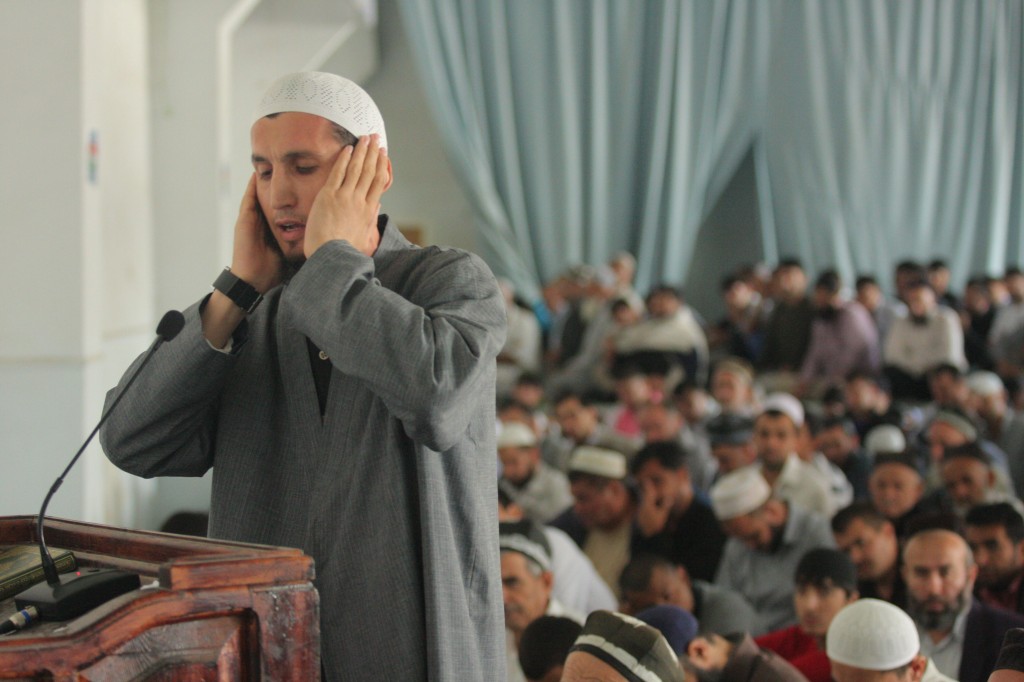
On Fridays a special congregational prayer is made in the early afternoon, which is required of all Muslim men.
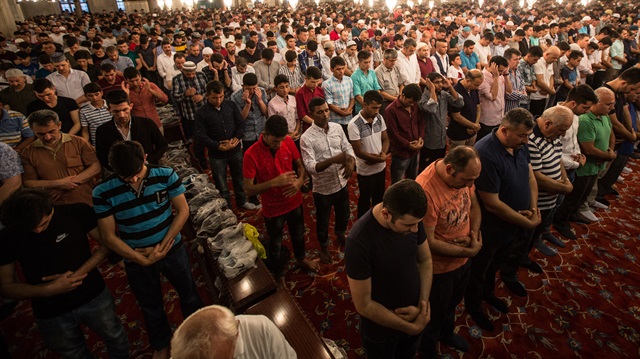
Each week on Friday, Muslims are required to take a bath, dress in their best clean clothes, wear perfume and assemble in the mosque for Friday Prayer.
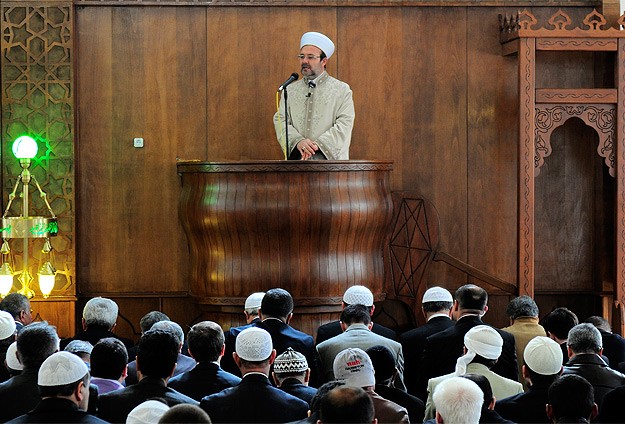
Directly before this prayer, worshippers listen to a lecture delivered by the imam or another religious leader from the community. This lecture reminds listeners about Allah, and usually directly addresses issues facing the Muslim community at the time.
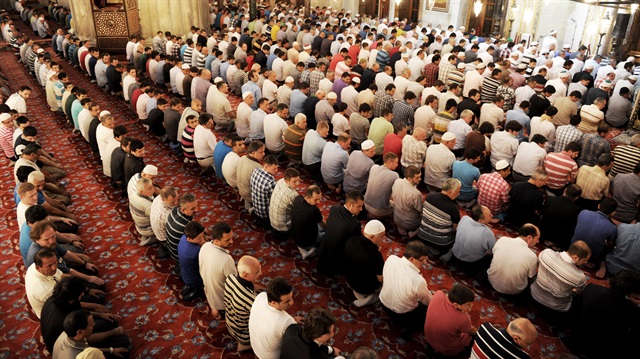
Friday Prayer is a convention for the Muslims to reassure themselves and confirm their religious bonds and social solidarity on moral and spiritual foundations.
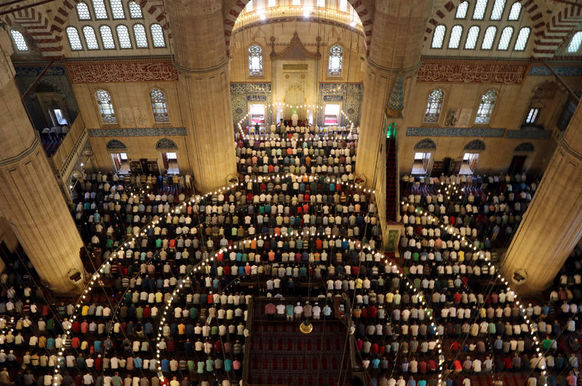
Friday Prayer must be said in a congregation led by an Imam.
A video about How To Attend a Muslim Friday Prayer Service


